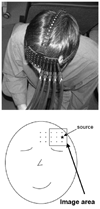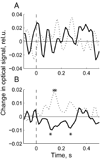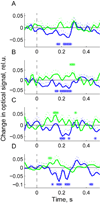Event-related fast optical signal in a rapid object recognition task: improving detection by the independent component analysis
- PMID: 18725213
- PMCID: PMC2668610
- DOI: 10.1016/j.brainres.2008.07.122
Event-related fast optical signal in a rapid object recognition task: improving detection by the independent component analysis
Abstract
Noninvasive recording of fast optical signals presumably reflecting neuronal activity is a challenging task because of a relatively low signal-to-noise ratio. To improve detection of those signals in rapid object recognition tasks, we used the independent component analysis (ICA) to reduce "global interference" (heartbeat and contribution of superficial layers). We recorded optical signals from the left prefrontal cortex in 10 right-handed participants with a continuous-wave instrument (DYNOT, NIRx, Brooklyn, NY). Visual stimuli were pictures of urban, landscape and seashore scenes with various vehicles as targets (target-to-non-target ratio 1:6) presented at ISI=166 ms or 250 ms. Subjects mentally counted targets. Data were filtered at 2-30 Hz and artifactual components were identified visually (for heartbeat) and using the ICA weight matrix (for superficial layers). Optical signals were restored from the ICA components with artifactual components removed and then averaged over target and non-target epochs. After ICA processing, the event-related response was detected in 70%-100% of subjects. The refined signal showed a significant decrease from baseline within 200-300 ms after targets and a slight increase after non-targets. The temporal profile of the optical signal corresponded well to the profile of a "differential ERP response", the difference between targets and non-targets which peaks at 200 ms in similar object detection tasks. These results demonstrate that the detection of fast optical responses with continuous-wave instruments can be improved through the ICA method capable to remove noise, global interference and the activity of superficial layers. Fast optical signals may provide further information on brain processing during higher-order cognitive tasks such as rapid categorization of objects.
Figures








References
-
- Aronson R, Barbour RL, Lubowsky J, Graber HL. Application of transport theory to infrared medical imaging; Proc. 11th International Conference on Transport Theory. Operator Theory: Advances and Applications; May 22–26, 1989; Blacksburg, VA: Birkhauser Verlag Press; 1991. pp. 64–75.
-
- Baba JS, Cameron BD, Theru S, Coté GL. Effect of temperature, pH, and corneal birefringence on polarimetric glucose monitoring in the eye. J Biomed Optics. 2002;7:321–328. - PubMed
-
- Baert AL, editor. Encyclopedia of Diagnostic Imaging. Berlin: Springer; 2008.
-
- Barbour RL, Graber HL, Aronsonza R, Lubowsky J. Model for 3-D optical imaging of tissue; Int. Geosci. and Remote Sensing Symp. (IGARSS); 1990. pp. 1395–1399.
-
- Barbour RL, Graber HL, Aronson R, Lubowsky J. Imaging of subsurface regions of random media by remote sensing. Time-Resolved Spectroscopy and Imaging of Tissues; Proc Soc Photo Opt Instrum Eng; SPIE; 1991. pp. 192–203.
Publication types
MeSH terms
Grants and funding
LinkOut - more resources
Full Text Sources
Other Literature Sources
Miscellaneous

